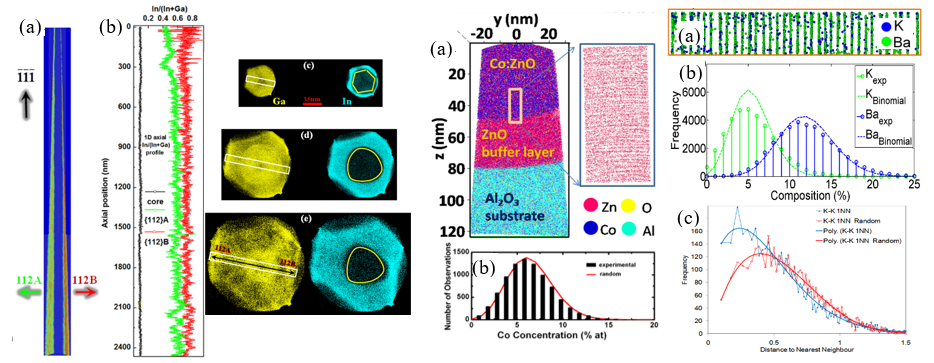报告题目: Atomic-scale tomography of semiconductors and superconductors
报告人: Rongkun Zheng, The University of Sydney, Australia
时 间: 10月18日(周三)下午3:00-4:00
地 点: 卢嘉锡楼202报告厅
以下是报告的摘要部分:
Abstract:
Atom Probe tomography have been applied to solve the critical questions in semiconductor [1, 2] and superconductor [3] materials. We have demonstrated that, in the analysis of semiconductor nanowires epitaxially grown from a substrate, the presence of the flat substrate positioned only micrometers away from the analyzed tip apex alters the field distribution and ion trajectories, which provides extra image compression that allows for the analysis of the entire specimen. In InGaAs nanowires, we have revealed and explained: (1) Ga-rich core and In-rich shell structure was grown via different mechanisms; (2) the decomposition rate of the group III precursors determines the In/Ga ratio in the core; (3) The dimension of core increases from 45 to 65 nm and the shape of the core changes from a hexagon to a rounded triangle from the top to the base of the nanowire; (4) The In/Ga ratio and inhomogeneous distributions of group III atoms in the {112}. In order to unravel the magnetism of Co doped ZnO films, we have performed rigorous experiments on Co doped ZnO grown on α-Al2O3 and O-polar ZnO (0001) substrates. In both cases, atom probe tomography confirms a random distribution of Co ion even at the interface region. In the ZnO:Co on α-Al2O3 substrate, the interaction between high density of threading dislocation, dopants, native point defects holds the key to understand the hitherto puzzling ferromagnetism observed in wide variety of doped and undoped semiconductors. However, in the ZnO on the O-polar ZnO (0001) substrate, hydrogen plays a key role in mediating magnetic ordering. Local fluctuations in the distribution of dopant atoms are thought to cause the nanoscale electronic disorder or phase separation in pnictide superconductors. Atom probe tomography has enabled the first direct observations of dopant species clustering in a K-doped 122-phase pnictide. First-principles calculations suggest the coexistence of static magnetism and superconductivity on a lattice parameter length scale over a wide range of dopant concentrations. Our results provide evidence for a mixed scenario of phase coexistence and phase separation, depending on local dopant atom distributions.

Figure: Reconstructions and analyses of semiconductor nanowire, Co doped ZnO, and pnictide superconductor.
[1] J. T. Qu et al, ACS Appl. Mater Interfaces, (2016); Adv. Mater. Adv. Mater. 2017, 29, 1701888 (2017)
[2] L. Li, et al., Physical Review B, (2012).
[3] W. K. Yeoh, et al., Physical Review Letters, (2011).
欢迎有兴趣的老师和同学参加!
固体表面物理化学国家重点实验室
biwn必赢
2017年10月15日
